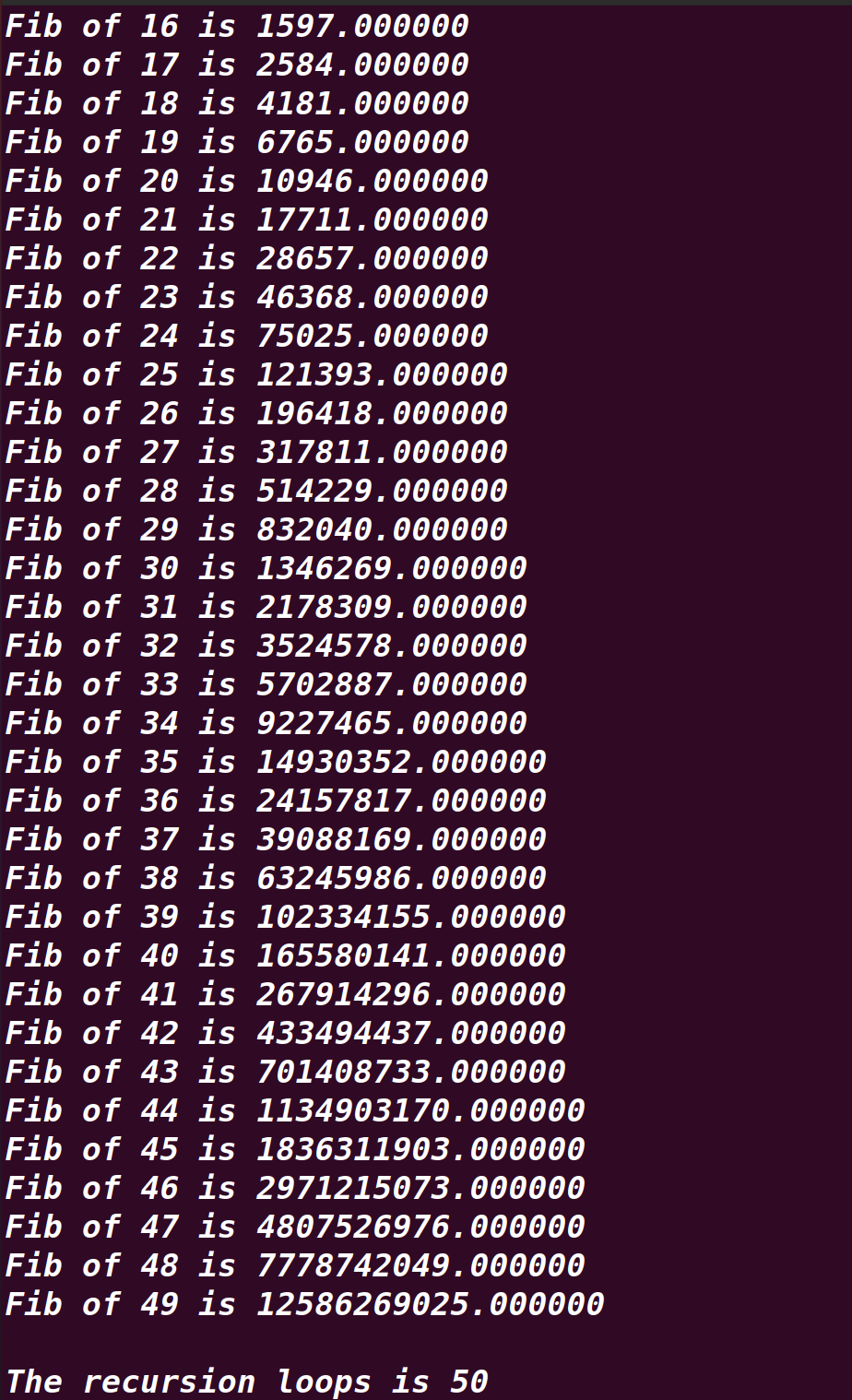Original Fibonacci and optimized Fibonacci functions and use the third variable to log the recursion times quantitatively
The common or classic Fibonacci algorithm
//Util.h static unsigned long long factorialLoops; long double Fibonacci35(int len); //Util.cpp unsigned long long Util::factorialLoops=0; long double Util::Fibonacci35(int i) { Util::factorialLoops++; if(i==0 || i==1) { return 1; } else { return Fibonacci35(i-1)+Fibonacci35(i-2); } } //In main.cpp void recursion16(int i) { Util ul; long double fib = 0; for (int x = 0; x < i; x++) { fib = ul.Fibonacci35(x); cout <<fixed<< "Fib of " << x << " is " << fib << endl; } cout<<"The recursion loops is "<<Util::factorialLoops<<endl; } int main(int args, char **argv) { recursion16(atoi(argv[1])); return 0; }
Compile via g++ and run as ./h1 50.The following snapshot will illustrate the inefficient reasons which located at call the method itself 65902560146(65B) times.It's evitable that the redundant time cost located at more than 65 billion times call the Fibonacci itself

While in the optimized method
//Util.h static unsigned long long factorialLoops; static map<int,long double> mp; long double Fibnacci36(int len); //Uti.cpp unsigned long long Util::factorialLoops=0; map<int,long double>Util::mp; long double Util::Fibnacci36(int i) { Util::factorialLoops++; if(i==0 || i==1) { Util::mp.insert(pair<int,long double>(i,1)); } else { long double mpValue=(long double)(Util::mp.find(i-1)->second+Util::mp.find(i-2)->second); Util::mp.insert(pair<int,long double>(i,mpValue)); } return Util::mp.find(i)->second; } //main.cpp void recursion17(int x) { Util ul; for(int i=0;i<x;i++) { cout<<fixed<<"Fib of "<<i<<" is "<<ul.Fibnacci36(i)<<endl; } cout<<endl<<"The recursion loops is "<<Util::factorialLoops<<endl; } int main(int args, char **argv) { recursion17(atoi(argv[1])); return 0; }
Compile and run the optimized method as above,it will print the following snapshot immediately which demonstrates the third variable only ran 50 times.While the common or usual Fibonacci method will run more than 65 billion times.

In the help of the third variable,we can found the root cause located at the help of the map collection which stores the computed result immediately and no need to calculte the expected former result from the scratch again and again.






【推荐】国内首个AI IDE,深度理解中文开发场景,立即下载体验Trae
【推荐】编程新体验,更懂你的AI,立即体验豆包MarsCode编程助手
【推荐】抖音旗下AI助手豆包,你的智能百科全书,全免费不限次数
【推荐】轻量又高性能的 SSH 工具 IShell:AI 加持,快人一步
· 分享一个免费、快速、无限量使用的满血 DeepSeek R1 模型,支持深度思考和联网搜索!
· 基于 Docker 搭建 FRP 内网穿透开源项目(很简单哒)
· ollama系列01:轻松3步本地部署deepseek,普通电脑可用
· 25岁的心里话
· 按钮权限的设计及实现
2020-04-19 dynamic intercept and interpret all method calls via implementation IDynamicMetadataObjectProvider
2020-04-19 get caller member name,caller file path,caller line number via attributes
2020-04-19 try catch exception when